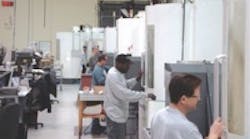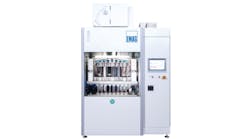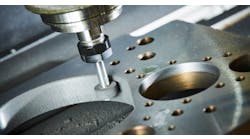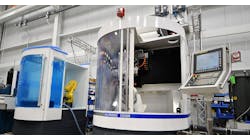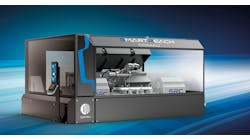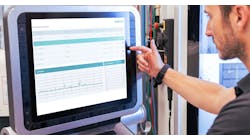IN A NORMAL WORK week, K&L Microwave Inc. contends with more than 200 machine setups that must be done as quickly as possible to keep the shop competitive in its market. K&L Microwave manufactures RF and microwave filters used in military, wireless and satellite communications systems, and its internal customers do not negotiate delivery times — they want the product when they want it, or they will go elsewhere for it.
To reduce setup times and speed overall job turnarounds, K&L Microwave (www.klmicrowave.com) standardizes its equipment and procedures wherever it can. As a result, the shop sets up machines in 5 min. (3 min. in some instances) and turns jobs around within five days, sometimes even within one day. Setups used to take upwards of 8 min., and job turnaround times averaged 10 days.
At K&L Microwave, standardization starts with machine tools. When the shop installs a line of machines, they are identical types and brands. For instance, the shop runs a line of six horizontal machining centers all from the same builder, Kitamura Machinery of U.S.A. Inc. (www.kitamura-machinery.com).
According to Joe Searing, supply chain director at K&L Microwave, standardized machines keep job setups standard, not just from a machining standpoint, but also for programming. "Being able to write a program that can be used on any one of the machines in the line allows us to quickly change over from job to job. We must constantly focus on speed and flexibility when it comes to processing jobs because we produce engineered-to-order products," he added.
When jobs come in, they are programmed and go right to one of the horizontals in the line. Shop personnel follow specific processes to get parts setup as fast as possible. For example, programmers work from a standard list of tools, and machinists work from standard/fixed machine offsets that help them determine which job is best run on which machine. If a machine is busy, they can easily switch the job to another in the line. "For a shop that runs several machines all from different builders, this is tough to do," Searing said.
Since machinists work from standardized machine offsets, they waste no time probing or edge finding for part position at the start of a job. All workholding, no matter what part is involved, references from the same offsets on each machine. Therefore, all parts on each machine's pallet are justified to the machine — it knows where they are — without extra effort.
K&L Microwave's machine programmers generate an average of 30 programs per day. Besides working from standard lists of tools, they help speed job setups by using what the shop refers to as "golden standard" programs. These are proven programs that machine operators know are validated and ready to run. In the past, the shop wasted time re-validating programs every time a job repeated. To the programmers' credit, Searing said the shop experiences no machine crashes because of programming errors.
Standard tool lists apply specifically to K&L Microwave's Kitamura machining centers, including the ones that accommodate only 40 tools in their magazines. In addition to lists, the shop uses a "cart" system at each machine. The carts, in essence, double the tool capacity of the machines by holding tools specific to certain jobs. While most of the machine tool magazine pockets hold tools that are standard across all jobs, the shop reserves pockets for tools that change from job to job. Those tools come from the cart.
With the cart system, machinists always know what tool is in which magazine pocket, so they do not have to waste time walking around the side of a machine to see where tools are. If a machinist needs to exchange a tool in a magazine or on a cart, he uses the shop's "tag" system.
Each tool, whether in the magazine or on the cart, has a corresponding numbered tag that lists the type of tool it is and its length. When a tool is moved, for example, from a cart to a magazine pocket, the machinist places its corresponding tag in the appropriate space on a "tag board." Tag boards, located at every machine, have spaces that represent each magazine pocket number and each cart pocket number.
"We have standardized our non-standard tools," explained Ed Conklin, continuous improvement manager of the machine shop at K&L Microwave. About 10 or so tools change from job to job, so that many magazine pockets typically are kept open on each machine. These "always open" pockets, together with the cart and tag systems, eliminate the guesswork as to which tools are needed for a job, allow for tracking where tools are between jobs and reduce setup times by letting the shop prepare tooling for a job ahead of time.
Standardized machines, tooling and workholding also provide flexibility to handle changing job priorities and make job scheduling less of an issue at K&L Microwave. This is because standardization allows any machinist in the shop to run any job on any one of the machines in the line.
Some machinists are assigned to specific machines. The shop refers to those machines as their "home rooms." However, if needed, a machinist can go from any machine to the next seamlessly and without holding up production. In fact, Searing said the shop's machinists pride themselves on being fast and being able to run different machines. "It is more than just standardized equipment and procedures. Success in our production environment also depends on an experienced labor force that rises to the occasion at crunch times and is willing to constantly learn," he said.
In the case of slightly long-run jobs, machinists will run multiple machines, usually during the shop's "fourth shift." Twelve-hour shifts on Friday, Saturday and Sunday make up the fourth shift. Regular shift personnel routinely evaluate jobs and set aside those with substantial volumes or those that are similar to one another for the fourth shift so that those jobs do not tie up machines during regular work times.
K&L Microwave's Kitamura machining centers are two-pallet systems. Searing explained how the shop uses them to further reduce job turnaround times: "Instead of loading one job and running it until it is complete, we load multiple jobs on tombstones mounted on our pallets, then bounce back and forth between those jobs, running each one for about an hour at a time." He said that allows the shop to process as many as 8 different jobs simultaneously on each machining center so it can service multiple customers at one time. In addition, this limited run-time practice keeps a constant supply of parts flowing to secondary downstream operations. No one has to wait for parts.
Searing also said that job setup and changeover times are shorter because of inherent design features of horizontal machining centers. The machines quickly and efficiently wash chips off workpieces and evacuate those chips from the work envelope, so operators do not waste time doing it themselves between pallet changes.
Another design feature that Searing said helps K&L Microwave is the high spindle-utilization rates that horizontal machining centers deliver (see "Automate or die," AMERICAN MACHINIST Feb. 2007). Prior to its horizontal machining centers, the shop used a line of vertical machining centers. Searing pointed out that "those machine spindles were in the metal" only about a third of the time, with operators spending substantial time flipping parts over, cleaning chips out of the machines and loading tools.
Committed to improving your shop operations?
American Machinist's Machine Shop Workshop is November 7-9, 2007.
Learn how to:
- Use our benchmark measurements.
- Create a strategic improvement plan tailored to your business.
- Become more competitive and increase profit.
- Register today at: www.americanmachinist.com/workshop2007.
